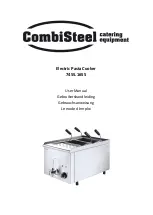
REFRIGERATION SERVICE
General:
••
Scotsman recommends that any work on the
refrigeration system only be done when it is
certain that the system needs repair.
••
Refrigerant should not be added except as a
way to determine the proper operation of the
product. If the system was low on refrigerant,
there is a leak, and it must be found and
repaired.
••
Although this system uses R-22, it should not
be wasted to the atmosphere, but reclaimed.
••
This system has a critical charge, it must be
recharged with the correct amount of refrigerant
as listed on the nameplate of the ice machine,
or performance will suffer.
••
Anytime the refrigeration system has been
opened, the dryer should be replaced.
••
When brazing the tubing connections to the hot
gas valve or thermostatic expansion valve, the
component must be protected by heat sink
material.
Specifically:
Recover, reclaim or recycle refrigerant. The
method chosen is up to the service company.
There are various mechanical devices that may be
used to recycle refrigerant at the field level,
however, Scotsman requires that any refrigerant
placed into a Scotsman ice machine meet ARI
spec 700. Reclaim programs are available thru
most refrigerant wholesalers.
Use conservation minded service procedures:
••
Refrain from checking refrigeration pressures
without reason. There are many ways to
determine the proper operation of a Scotsman
ice machine without using refrigerant gauges.
Visual inspection of the water system,
observation of the ice formation, amp draw,
voltage, and other techniques will lead to proper
diagnosis. Scotsman also recommends that, at
the time of initial start up, gauges not be used.
••
If gauges must be used, do not always check
the high side pressure. If the condenser is clean
and seems to be operating correctly, it most
likely is. The low side pressure is much more
important on an ice machine than is the high
side.
••
If gauges must be used, use very short hoses.
Minimal refrigerant discharged into the hoses
equals minimal refrigerant discharged into the
air.
••
If hi side pressure must be checked, use a
quick connect at the end of the discharge hose
to minimize the release of refrigerant, J/B
Industires part number A33000 works well.
••
Scotsman’s schrader valve caps must be
tightened to 70 inch - pounds to insure that the
valves will not leak.
••
If using recycled refrigerant, it must meet ARI
spec 700 or have been cleaned by a machine
capable of attaining ARI spec 700.
If the refrigeration system must be serviced, the
quality of service must insure that there will not be
a repeat failure, as repeat failures will cause
refrigerant to be discharged into the air by the
failure or when the failure is corrected:
••
If there has been a compressor burn out, check
for acid in the oil. If acid is indicated, extra steps
must be taken to clean up the system.
••
Never use refrigerant, such as R-11, to clean
up or flush out a refrigeration system. When
system clean-up is required, the use of suction
line filter-dryers and liquid line filter-dryers are
recommended.
••
Always replace the dryer when repairing a leak
or replacing a refrigeration component.
••
Evacuate the system with a good vacuum
pump to 500 microns or less. If the triple
evacuation method is used, the vacuum should
be broken each time with dry nitrogen, not
refrigerant. Evacuation must be from both sides
of the system.
••
Weigh in or measure in the nameplate charge.
Recharge into the high side.
••
Check for leaks with a high quality, electronic
leak detector. Halide torches will not locate the
very small leaks.
••
Scotsman’s schrader valve caps must be
tightened to 70 inch - pounds to insure that the
valves will not leak.
If an ice machine is to be discarded and still
contains refrigerant, Scotsman recommends that
the refrigerant be recovered, reclaimed, or
recycled so that it is not discharged into the air.
CMS1402
September 1993
Page 25

































